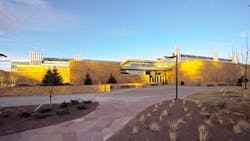Architects salute sustainability at 2 higher-education facilities
Facilities at the University of California at Berkeley and the University of Wyoming have been singled out as examples of sustainable architecture and ecological design by the American institute of Architects (AIA) and its Committee on the Environment (COTE).
The Jacobs Institute for Design Innovation at UC Berkeley and the Visual Arts Facility at the University of Wyoming were recognized for their outstanding green design by the AIA as part of the 2016 COTE Top Ten Awards program.
The Jacobs Institute is “a collaborative, project-based educational space and a symbol to the region of the University’s commitment to sustainable innovation,” the AIA says.
Completed in 2015 on the site of a former campus volleyball court, the 24,000-square-foot building includes flexible design studios, project rooms, support spaces and fabrication equipment rooms containing a variety of rapid prototyping tools and equipment. It is designed to use 90 percent less energy than the national median for university buildings.
The Visual Arts Facility at the University of Wyoming campus in Laramie “provides a teaching and learning environment that is both state-of-the-art in occupational safety and in its concern for discharge of pollutants from building,” the AIA says.
The 77,484-square-foot facility, which opened in 2012, has spaces for art history instruction along with studios and labs for ceramics, sculpture, painting, drawing, small metals, printmaking, graphic design, and digital arts.
The building’s vast roof area provides space for one of the largest solar evacuated tubes in the nation. The university estimated he that the solar thermal system would reduce carbon emissions by an estimated 5,000 to 6,000 tons of over the next 50 years.
About the Author
Mike Kennedy
Senior Editor
Mike Kennedy, senior editor, has written for AS&U on a wide range of educational issues since 1999.

